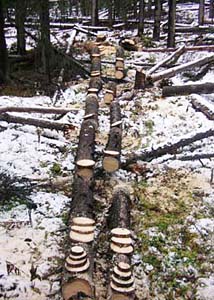Research Projects
Selected Completed Projects
Response of western redcedar growth to climate and hemlock looper outbreaks in the inland temperate rainforest of BC. (Chris Konchalski, MSc completed 2014)

Northern range limit mountain pine beetle outbreak dynamics and climate interactions in mixed sub-boreal pine forests of British Columbia. Kate Hrinkevich
Hrinkevich, K. and Lewis, K.J. 2011. Northern Range Limit Mountain Pine Beetle Outbreak Dynamics in Mixed Sub-boreal Pine Forests of British Columbia. Ecosphere. 2:Article 116.
The objectives of this study were to develop a long-term record of mountain pine beetle (MPB) outbreaks near the northern limit of the species’ range and to examine the interacting factors driving that disturbance regime. Using a combination of dendrochronological methods to reconstruct stand and outbreak history together with long-term local and large-scale climate data, an integrated model of outbreak dynamics was developed for north-central BC where little is known about the role of MPB in forest stand dynamics or the influence of climate on outbreak development. A 200-year outbreak reconstruction was used to determine that host susceptibility and mortality patterns had distinctly different characteristics than those described further south.


Wood decay and degradation in standing lodgepole pine killed by mountain pine beetle.
Lewis, K. and Thompson, R.D. 2011. Wood degradation in standing lodgepole pine killed by mountain pine beetle. Wood and Fiber Science. 43:1-13.
Lewis, K.J., Thompson, R.D., Hartley, I. and Pasca, S. 2006. Wood decay and degradation in standing lodgepole pine (Pinus contorta var. latifolia Engelm.) killed by mountain pine beetle (Dendroctonus ponderosa Hopkins: Coleoptera). Mountain Pine Beetle Initiative, Working Paper. 2006-11. Canadian Forest Service.
Lewis, K.J. and Hartley, I. 2005. Rate of deterioration, degrade and fall of trees killed by mountain pine beetle: a synthesis of the literature and experiential knowledge. Working Paper 2005-14. Natural Resources Canada, Canadian Forest service, Pacific Forestry Centre. 20p.
The rate of tree fall in beetle-affected stands, and the biophysical factors that affect wood quantity and quality in individual trees following mortality was quantified for areas of central BC and Alberta. External indicators used to estimate year of mortality were not accurate, particularly for trees that had been killed in the earlier stages of the epidemic.Destructively sampled dead trees were cross-dated against live trees to determine the year of mortality. Drying, bluestain and checking were the major causes of decline in wood quality and quantity in recently killed trees (1-2 years). Saprot and ambrosia beetles became established during the first 2 years post-mortality, but then held steady and did not increase in depth of penetration, with the exception of the basal section of the tree where moisture content remained well above fibre saturation point allowing continued colonization by decay fungi. Location along the stem and tree size are major contributors to the variation detected in the factors of wood quality and quantity.

The relationship between climate and outbreak dynamics of Dothistroma needle blight in northwest British Columbia. Cedar Welsh.
Welsh, C., Lewis, K., Woods, A. 2014. Regional outbreak dynamics of Dothistroma Needle Blight Linked to weather patterns in British Columbia, Canada. Canadian Journal of Forest Research. 44:212-219.
Welsh, C., Lewis, K.J. and Woods, A. 2009. The outbreak history of Dothistroma needle blight; an emerging forest disease in northwest British Columbia, Canada. Canadian Journal of Forest Research. 39: 2505-2519.
Dothistroma needle blight is an economically important forest disease, which causes serious defoliation of exotic pine. The fungus responsible for the disease, Dothistroma septosporum (Dorog.) Morlet infects the needles, leading to needle death and reduced yield. Until recently, Dothistroma needle blight has been uncommon and of little concern in lodgepole pine stands in western North America. Since the late-1990s, severe damage to managed and natural stands of lodgepole pine has been reported from northwest British Columbia. Historically, the effect of defoliation on native host trees was a reduction in growth, and decline in tree vigor. Recently, however, this has dramatically changed in British Columbia where high levels of mortality have been documented.
Dothistroma needle blight poses a significant threat to the growth and yield of lodgepole pine in northwest British Columbia. Both increased host density and favourable weather patterns have been suggested as major catalysts of the current spread and severity of the disease. The purpose of this research was to compare the influence of climate on the extent and nature of past Dothistroma needle blight outbreaks to understand the spatial and temporal variations of the disease in lodgepole pine-dominated forests of northwest British Columbia. The main objectives were: (1) to reconstruct the outbreak history of Dothistroma needle blight at multicentury time scales through dendrochronological techniques; (2) to identify the best climate or proxy data to document historical climate; and (3) to determine the relationship between climate and the historical outbreak dynamics of the disease.


